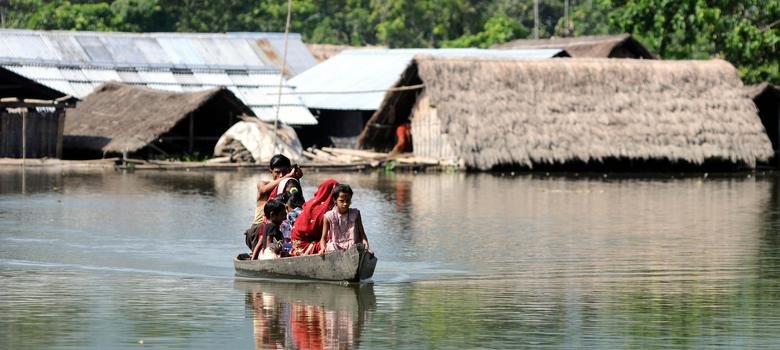Annual Assam’s Floods: A Decade of Debates and Promises

It’s the time of year when vast swathes of the Indian state of Assam battle the annual deluge. The Assam’s Floods, which began in May, have already claimed more than 90 lives and rendered hundreds of thousands homeless. Most of the major roads are now under water and crops, embankments, and bridges have been ravaged by Assam’s Floods. On July 14, 244,629 persons across 18 of the state’s 35 districts were affected. More than 30,000 people who have been left homeless by the floods have taken shelter in 172 relief camps
It is at these times that debate and discussion about better management of floods and excess rainwater in the Brahmaputra River and its tributaries gather momentum. But, after the monsoon is over and floodwaters have receded, such debates are conveniently forgotten and await revival the next year when the deluge and deaths recur.
Promises and Policies
Assam’s Floods are not only the subject of debates and media headlines but a recurring theme in political manifestoes and promised policies as well. Union Minister for Road Transport and Highways, Shipping, and Water Resources Nitin Gadkari announced in July 2017 that dredging would start in September from the Brahmaputra River. It had been assured by Sarbananda Sonowal, the then Chief Minister of Assam, the previous year. Dredging, meaning removing the excessive silt from the riverbed by big vessels called dredgers, was to be done in order to increase the river’s water retention capacity and minimize flood and erosion.

In 2017, another plan for a riverbank expressway, from Sadiya to Dhubri along the Brahmaputra River was announced. This expressway should be 1300 km in length, be made of excess silt collected during dredging, and will require ₹40,000 crore. It aims at improving the road network in Assam besides avoiding erosion of land along the river.
The ruling party, Bharatiya Janata Party, assured in March 2021 that it would make Assam totally free of floods. When releasing the manifesto, BJP national president JP Nadda committed to the execution of “Mission Brahmaputra,” which includes scientific dredging, tributary management, and constructing big reservoirs for excess water diversion.
Implementation and Challenges
These projects undertaken for mitigating the severity of Assam’s Floods remain much in their poor implementation. While the Inland Waterways Authority of India annually undertakes dredging to keep certain stretches of the Brahmaputra navigable for ferries and boats, large-scale dredging for mitigation has yet to take off.

The Dredging Corporation of India, in February 2023, had entered into a ₹204.5 crore pact with IWAI for the maintenance and development of national waterways on rivers in the northeast, including the Brahmaputra, Dhansiri, Barak, and Kopili. Although the project mandate is to maintain a 32-meter-wide and 2 to 2.5-meter-deep fairway, more importantly, it aims at ensuring navigability, not flood control.
Not much progress was made on the expressway project either. In February 2021, Gadkari told the Rajya Sabha that there was no such proposal for constructing the expressway with surplus silt from dredging the Brahmaputra.
There has been no real progress toward Mission Brahmaputra as promised in BJP’s manifesto in 2021. The Union or state government in its budget announcements has hardly mentioned anything about the said project.
Political Blame Game
Flood management is one of the prime political issues in Assam because it affects millions every year. The political parties have been putting the blame on each other for not solving the issue. Congress President Mallikarjun Kharge has targeted the BJP over its promise to make Assam free from floods, which it could never fulfill. Another congress MP Gaurav Gogoi has triggered yet another attack on the state government saying that the Water Resources department had become an “automated teller machine” for big contractors. This had ineffective flood control measures in place.
Himanta Biswa Sarma, Chief Minister turned around the blame on the previous Congress government for their weak condition of embankments. He said most of the embankments breached by the water resources department this year were made during Congress rule. He added that in 2004 itself, during the Congress rule, 350 embankments breached.
Expert Opinions
Experts underline the fact that Assam’s Floods are a boon to agriculture. The silt carried by floodwaters increases the fertility of the soil, which is central to its agrarian economy. However, the very terminology of making Assam flood-free is not only undesirable but also impossible, according to them. “Assam is nourished and sustained by floods,” said Mirza Zulfiqur Rahman of the water infrastructure research group. Blaming populist measures like dredging and construction of expressways as financially burdensome in most cases, under pressure from the politician-contractor lobby, he added, “Floods are a major reason behind the rich biodiversity of Assam. As such, measures to control these Assam’s Floods would actually prove to be very expensive.”
Mr. Rahman is asking for an increase in the quantum of funds being spent over the Brahmaputra River so that some effective flood mitigation policies could be evolved. He said unplanned urbanization has taken a heavy toll on the wetlands, which in the process have reduced the natural flood mitigation capability of the basin area. Instead of large ponds, Mr. Rahman wishes to retain these wetlands and connect them so that floods could be managed more effectively.
The annual Assam’s Floods are a complex problem and hence require comprehensive and sustained efforts. Many promises and policies have been mooted, but the implementation usually remains in the pipeline. As such, it requires not just sustainable solutions but more research and involvement by the people for effective flood management. The crux of the argument is that for the long-term development and well-being of the proud-Assamese people and the economy at large, it is very important to tackle the root causes rather than looking for some short-term panacea measures for flooding.
